Sitting in the shadow of Snowdon in North Wales, Cliff Thomas tells the story of Llanberis Lake Railway, whose foundations stem from a former slate quarry line.
A check list of ingredients for a successful heritage railway might include: mountain landscapes (Snowdon, obviously!); running beside a lake; steam locomotives with local provenance; riding on an historic trackbed amid industrial archaeology; a long-established tourist location; and numerous supplementary attractions would score right up there.
The Llanberis Lake Railway ticks all those boxes – and with passenger numbers approaching the three million mark since opening in 1971 the formula plainly works.
These are big numbers for a small 1ft 11½ in-gauge railway. The one million passenger mark was passed during 1992/93 and the line sailed past two million in summer 1997.
Average annual traffic for the first 26 years of operation ran at 78,000, with a fall between 1997-2016 when the average reduced to just over 62,200 a year. However, in 2016 the railway was back to its historic figures, carrying 78,634 passengers – the highest annual total since 2008. The three million landmark is inexorably approaching!
Railway village
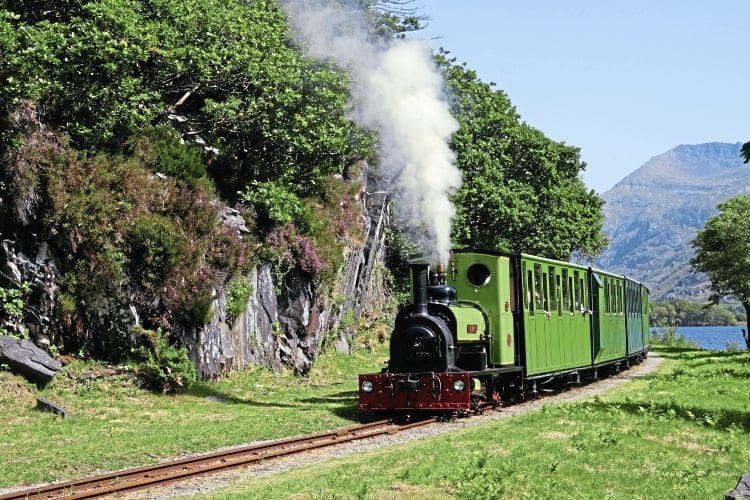
Llanberis has attracted tourists since Victorian times, inevitably leading to proposals to build a railway from the village to the top of the highest peak in Wales (and England) following arrival of the standard gauge branch from Caernarfon in 1869.
The rack-and-pinion mountain line was finally built between 1894 and 1896, the popularity of the village and Snowdon Mountain Railway continuing long after closure in 1964 of the London & North Western Railway branch to Llanberis; passenger services had ceased in 1932.
Contrasting with the tourist magnet village and its mountain railway on the southern shore of Llyn Padarn, the north shore of both this lake and Llyn Peris presented a scene of major industrial activity in the form of Dinorwic slate quarry.
Most of the workings of this significant operation, which are in the form of open galleries carved into the mountainside of Elidir Fach and Elidir Fawr, and the resulting tips of waste material, remain a highly visible feature of the landscape.
The quarry employed an extensive railway system (technically 1ft 10¾ in-gauge,
although wagons had double-flange wheels allowing ‘flexibility’ of gauge in the more lightly laid areas), worked by steam locomotives, the majority of which were Hunslet-built 0-4-0STs.
Varying in size and detail, these small locos (basically industrial plant in their original employment) and similar types from Penrhyn slate quarry and several smaller operations have become known under the affectionate generic ‘Quarry Hunslet’ tag in preservation.
The biggest issue for any North Wales slate quarry was transporting its production to market. Dinorwic finally solved this by building a railway from Gilfach Ddu (on the lake shore opposite Llanberis) to its own seaport on the Menai Straits, but not to the same gauge as the quarry network.
The Padarn Railway was a 4ft-gauge line with the narrower gauge slate wagons carried aboard transporter wagons to Penscoins at the coast above Y Felinheli, where the quarry wagons were offloaded and run down an incline into Port Dinorwic.
Closure and rebirth
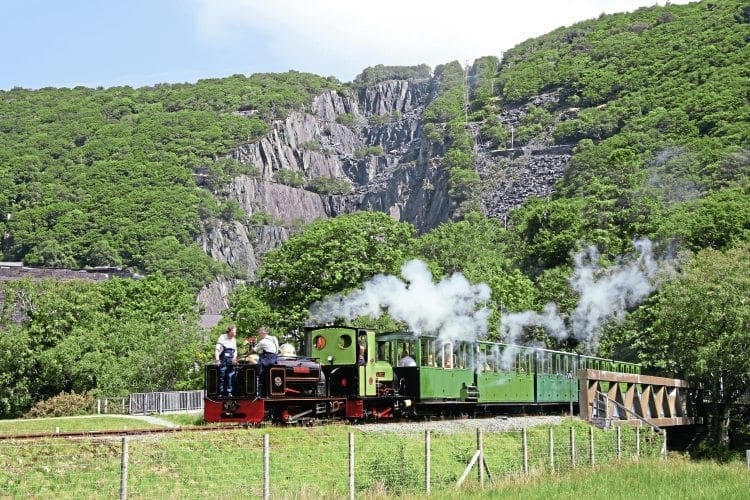
With the slate trade in decline, the Padarn Railway closed in 1961 and its track was lifted by 1963, with Dinorwic quarry closing on July 10, 1969. A month later, Dinorwic Slate Quarries Co Ltd went into liquidation.
By this time a number of locomotives – made redundant as the slate industry was contracting – had already been sold. The remaining equipment (including the last four steam locomotives) were to be sold at auction on December 12-13, 1969.
Although there was always tourism, the end of this major industry understandably caused concern in the area, leading a group of local people to set up Cymdeithas Rheilffordd Llyn Padarn (CRLP) to promote construction of the Llanberis Lake Railway (LLR).
CRLP was primarily aimed at creating local jobs and providing another tourist asset for Llanberis, and would utilise the trackbed of the Padarn Railway on the northern shore of the lake.
At the auction of Dinorwic quarry assets, Alan Porter (on behalf of the trustees of the Cymdeithas) successfully bid for three of Dinorwic’s Hunslet locomotives. Mr Porter became chairman of the Cymdeithas, which in 1976 was re-registered as Rheilffordd Llyn Padarn Cyf (Ltd), and later became honorary president of the company.
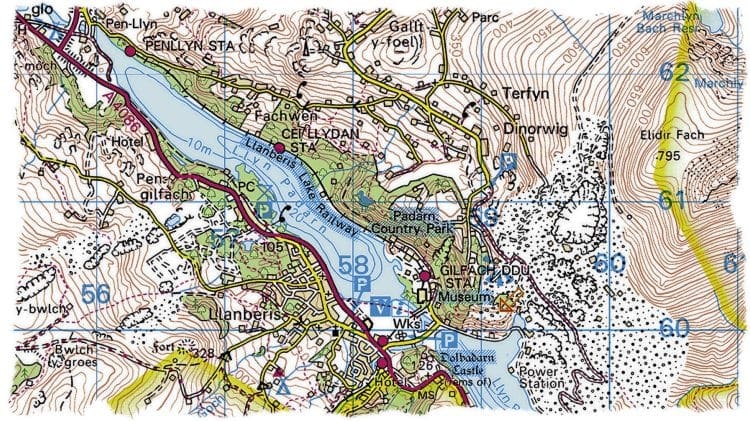
In simple terms, the three locomotives bought were Red Damsel (previously Enid), Wild Aster and Dolbadarn, but the acquisitions – assembled or otherwise – were in reality quite a mixed bag. Vic Bradley, the railway’s engineer, dismantled everything, arranged the components in three heaps, and started assembling the three locomotives now operated by the railway.
The resulting Dolbadarn (named after the nearby Dolbadarn Castle) was fairly straightforward, initially being given a red livery. It subsequently changed to yellow ochre, and a few years ago Dolbadarn was given a medium/light green livery.
The nameplates for Red Damsel had long-disappeared, and with concerns over its ‘proper’ identity and the propriety of its name it was called Elidir (after the mountain into which the Dinorwic quarries are carved) and given a red livery, which with periodical refreshing, has remained to the present day.
The third loco was named Thomas Bach (Little Thomas) after (so the railway insists) its driver in the quarries, and received a blue livery.
This colour has always been retained, but the loco did run with Wild Aster nameplates for a while after they were fitted for the line’s 40th anniversary gala in 2011, and then reverted to Thomas Bach. The railway has always presented its locos in different colours for commercial reasons.
New line opens

The two-mile line on the Padarn Railway trackbed, along the shore of Llyn Padarn, was opened in July 1971.
The locomotive shed and workshops were (and still are) those used by the Dinorwic locomotives in quarry days, located in one corner of the Gilfach Ddu works, now a slate industry museum.
There is a rail link into the courtyard, enabling the museum’s ex-Pen-yr-Orsedd Hunslet 0-4-0ST Una to occasionally steam on LLR.
The main station was developed where the Padarn Railway transporter wagon loading dock was located. The line passes the carriage sheds before running under the ‘Vivian Arch’ to assume its position on a lakeside ledge.
There is a passing loop at Cei Llydan (where trains pause on the return journey and passengers can use a lakeside picnic area) and terminates at Penllyn, simply a run-round loop with no platform.
Gilfach Ddu has the merit of being located next to the slate museum, Vivian quarry (a somewhat self-contained, now partially flooded, section of the Dinorwic operation), craft shops and car parking; the downside is its location on the far side of the lake from Llanberis and Snowdon Mountain Railway.
This was addressed by construction of an 875-metre (about half a mile) extension from Gilfach Ddu, parallel to the side wall of the museum (almost on a section of long-closed quarry-related track), across the access road and over the ‘river’ linking Llyn Peris and Llyn Padarn on to a new station at Pont Victoria on the edge of Llanberis village.
The £500,000 project was initially planned to open in 2000, but delayed by problems with the funding package, which included a European Regional Development Fund grant.
The scheme was supported by local tourist attractions, including Snowdon Mountain Railway, and was officially opened on June 6, 2003 by Welsh MP Dafydd Wigley, then leader of Plaid Cymru.
Public services started on June 9, providing a direct rail link from Llanberis into Padarn Country Park – some 700 acres of countryside, including the aforementioned attractions.

Other steam locomotives have worked on the LLR in past times, but the three Hunslet 0-4-0STs bought for the line in 1969 remain the core steam fleet, maintaining a two-train
peak service (one loco spare or under overhaul), which reduces to a single train at quieter times.
There are two rakes of carriages: one a set of fully enclosed vehicles with a set of summer carriages brought into use when the two-train service is operated.
The railway also has diesel locos for shunting and works trains.
Further expansion?

Llanberis Lake Railway could conceivably have expanded in a big way had things turned out differently. Around 1998, with Caernarfon’s Victoria Dock a contender for the location of a new National Museums and Galleries of Wales Maritime Museum, ideas of extending LLR from Penllyn into Caernarfon emerged, part of promoting Llanberis as a ‘green gateway’ to Snowdonia.
The idea was to initially utilise parts of the old Padarn Railway trackbed before transferring to the old standard gauge Caernarfon to Llanberis branch trackbed, where the two closed lines ran close to each other, near Pontrhythallt.
This line would link with Rheilffordd Eryri as it then was, now simply the Welsh Highland Railway, at the latter’s Caernarfon station, and continue through the old standard gauge tunnel under Castle Square, which had just been reopened as a road.
The Maritime Museum decision went in favour of Swansea and the expanded railway concept faded away – the question of funding such a project, let alone whether it could be operated profitably, never being addressed.
Current LLR general manager Emlyn Pritchard confirms there are no extension plans on the agenda, although projects to enhance the line are in the pipeline.
Promoting tourism and providing jobs

Llanberis Lake Railway was founded to promote tourism and provide local employment, and is run by 12 permanent staff, headed by Mr Pritchard, who joined the railway in April 2014, becoming general manager from November 1 that year.
He is backed by decades of experience. Drivers Hefyn Owen and Nigel Orritt have been with the railway for nearly 39 years and just over 30 years, respectively.
Workshop supervisor Gareth Davies has clocked up 33 years, and two other staff have been employed by LLR for more than 20 years. The dozen-strong core team are supplemented by 15 seasonal staff (five full-time and 10 part-time) in the cafe, retail areas and as guards.
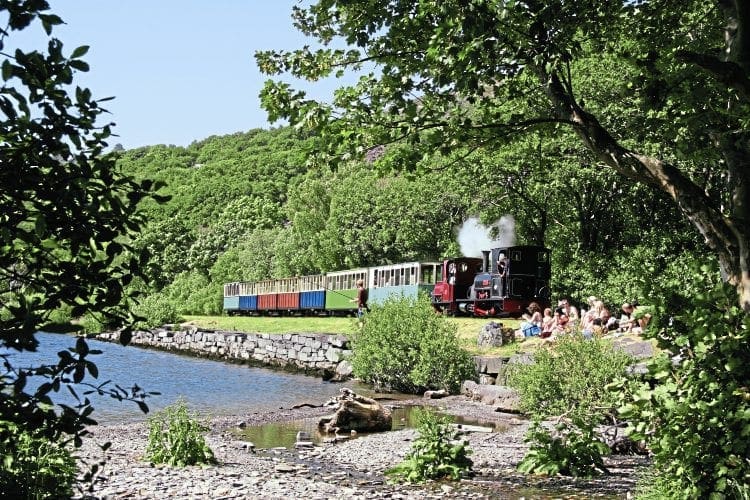
There is no volunteer supporting society, and while gala events are not a major entry on the railway’s calendar, they do periodically feature.
The railway pulled out all the stops in July 2011 to celebrate its 40th anniversary, all three resident steam locomotives (Elidir, Dolbadarn and Thomas Bach, running as Wild Aster) plus the slate museum’s Una were joined by a trio of guest locos, all of which had run on the LLR at some point in its past: Hunslet 0-4-0ST Maid Marian (from Bala Lake), Henschel 0-4-0T Helen Kathryn (South Tynedale Railway) and De Winton 0-4-0VBT Chaloner (Leighton Buzzard Railway).
It is unlikely there had previously been seven locos in action on LLR during a weekend, with even more steam present in the form of Fairbourne Railway’s ‘scale’ Darjeeling Himalayan Railway B-Class 0-4-0STT Sherpa – on a section of specially laid 12¼in-gauge track at Gilfach Ddu – and miniature locos running at Gilfach Ddu and Cei Llydan.
The last gala at Llanberis Lake was in 2014 and the next looks likely to be in spring 2018 to celebrate the return to steam of Thomas Bach – with a new boiler – after an absence of four years.
Part of a tourism package
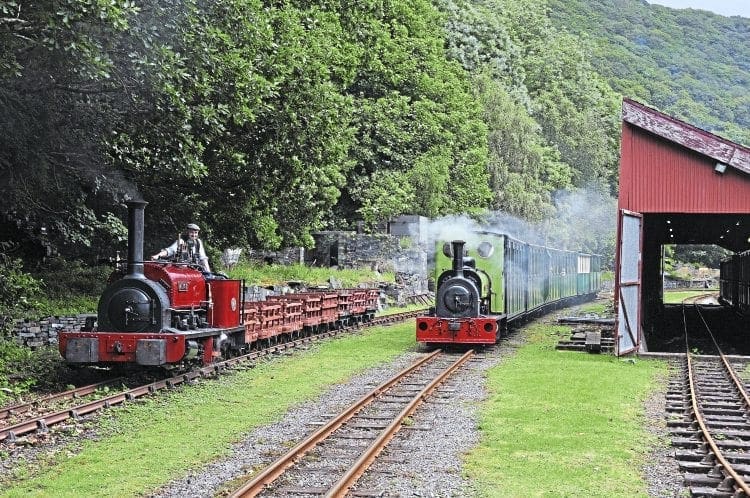
LLR has always been clear about its core traffic – coach parties (often retired people) and young families.
The coach party traffic is particularly important, gelling well with the requirements of such tours (scenery, interest and not too lengthy a stop to fit with the remainder of the trip itinerary) to the extent any extension could work against the railway in making the ride take too long.
Moreover, Llanberis provides an interesting example of how a cluster of tourist attractions work in concert with each other.
Snowdon Mountain Railway transports some 130-140,000 people a year to the summit of Snowdon. Far from being rivals, LLR and SMR complement each other.
In the high season, there can be a lengthy wait for SMR passengers before they can travel to the summit, so a trip over LLR can fill the time.
Similarly, if a young family finds the Snowdon fare too high they can be advised of the alternative railway trip just across the road. Weather conditions can also affect Snowdon services, alleviated by re-directing potential passengers to the LLR.
Also in Llanberis is Electric Mountain, a visitor centre in the village, which offers guided tours into the man-made caverns created in Elidir to house an electricity generating complex.
In the mid-to-late 1970s LLR derived ‘freight’ traffic in relation to the generating scheme resulting from the laying of underground cables buried beside its trackbed.
There is a pumping station, which draws cold water from the lake to cool the underground cables part-way between Cei Llydan and Penllyn, and a siding runs into the building, allowing heavy equipment to be transported to the site by rail.
Llanberis Lake Railway is very successful at what it does, fulfils the ambitions of those who promoted it, and happily, if quietly, has carved out its own special place in the North Wales narrow gauge scene.
The Welsh Slate Museum – Gilfach Ddu

The works complex at Gilfach Ddu, comprising a courtyard, surrounded by workshops, an administration section, and engineer’s house, is believed to have opened in 1870. It provided a virtually self-contained engineering and repair facility (it was not part of the slate production process) for Dinorwic quarry.
Equipment was auctioned off when the quarry closed in 1969, but the building and most of its contents were preserved, the site opening as a museum in May 1972, initially as the North Wales Quarrying Museum.
A £2.1million project between 1997-2000, supported by a £1.6m Heritage Lottery Fund grant, significantly enhanced the museum, which encompasses the main Gilfach Ddu site (now also including a row of relocated cottages), the old quarry hospital on the nearby hillside, and restoration of the V2 plane of the ‘tanc’ incline above LLR’s station, which served Vivian quarry.
The latter (the only working incline of its kind in Britain) is occasionally demonstrated, albeit now worked by an electric motor rather than gravity.
A collection of slate quarry rolling stock and ex-Pen-yr-Orsedd quarry Hunslet 0-4-0ST Una, which is sometimes steamed, is displayed in the Gilfach Ddu courtyard. Entry to the museum is free.
Padarn Railway (‘officially’ Dinorwic Quarry Railway)

The 4ft-gauge Padarn Railway opened in 1843, running seven miles from Gilfach Ddu, along the lake shore to Penllyn and on to Penscoins.
Here, slate wagons were unloaded from the transporter ‘host’ wagons (four wagons per host, or three plus a small enclosed brakesman van) and lowered down an incline to Port Dinorwic, where the slates were transferred into ships. Initially worked by horse, steam was introduced in 1848.
Although built to transport slate wagons, from around 1850 quarry workers were allowed to use their own vehicles (various forms of velocipede) over the railway to and from the quarry.
These machines were effectively replaced by a quarry company-operated workmen’s train, with ‘proper’ four-wheel coaches, from 1895. The workmen’s service ceased on November 8, 1947 and the railway closed on November 3, 1961.
Early steam was provided by two 0-4-0 tender locomotives, built by A Horlock and Co in 1848, remarkable in many ways, including not having frames, with such components as the wheels and fittings being mounted to the boiler.
Jenny Lind was withdrawn in the 1880s and scrapped. Fire Queen was withdrawn in 1886, but preserved in a dedicated shed at Gilfach Ddu.
Fire Queen is believed to be the earliest surviving narrow gauge steam locomotive, and is now part of the National Trust’s industrial railway collection at Penrhyn Castle.
A transporter wagon, three 1ft 10¾ in-gauge slate wagons, and a brakeman’s van (which was not brake-equipped, simply being a mobile shelter for the Padarn Railway train’s brakeman) are displayed at the Narrow Gauge Railway Museum at Tywyn Wharf.
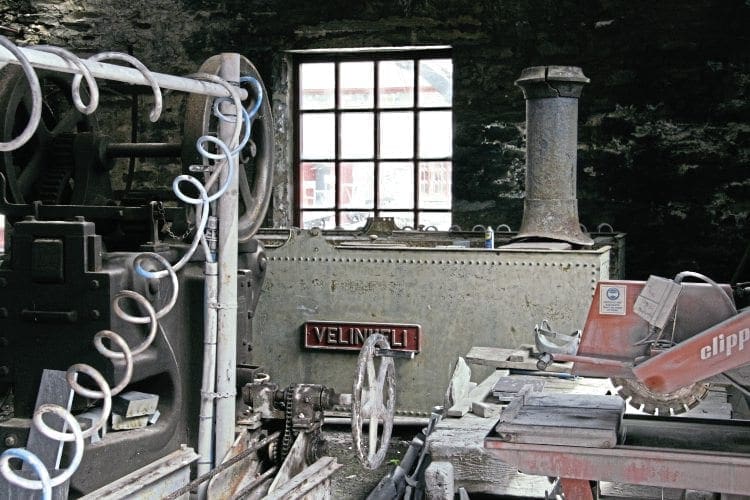
The Horlock locos were superseded by conventional 0-6-0Ts, built by Hunslet: Dinorwic (1882, scrapped 1963), Pandora (1886, Amalthea from 1909 and scrapped 1963) and Velinheli (1895, dismantled for overhaul 1953).
The majority of Velinheli’s components were scrapped in 1963, but the side tanks (one with nameplate) and chimney survived, and can be seen at today’s slate museum.
The Railway Magazine Archive
Access to The Railway Magazine digital archive online, on your computer, tablet, and smartphone. The archive is now complete – with 123 years of back issues available, that’s 140,000 pages of your favourite rail news magazine.
The archive is available to subscribers of The Railway Magazine, and can be purchased as an add-on for just £24 per year. Existing subscribers should click the Add Archive button above, or call 01507 529529 – you will need your subscription details to hand. Follow @railwayarchive on Twitter.


